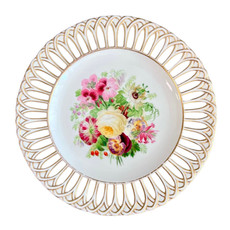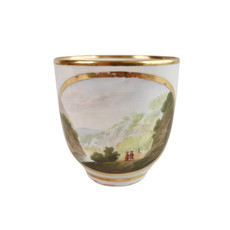Mr Greatbatch's flowers
It is spring! It is a mighty cold April here in the UK so we are all still shivering indoors, but my tulips are out in force, and the porcelain flowers also keep coming. Today a collection of plates with wonderful flowers painted by the great porcelain artist known as Greatbatch. We don't know his first name, only that he specialised in flowers and worked with his brother R., whom we at least know the initial of. R. was a talented gilder, and the brothers worked at the Copeland factory between about 1845 and 1860. They became celebrated when Copeland let them exhibit some pieces they decorated together at the Great Exhibition of 1851, which was one of the first grand corporate trade events.
So first a word about the Copeland factory... this was the third iteration of the famous Spode factory, after the "Copeland & Garrett" period which transitioned into the "Copeland" period in about 1833. The Spode/Copeland factory was one of the most prominent potteries right from the start of English porcelain production in the late 1700s to the demise of the industry in the 1960s and ultimate closure in the early 21st Century. In fact it was the founder Josiah Spode who was responsible for the recipe for bone china that made English china production so successful in the two centuries to come. Throughout all the changes, their items have always remained of exceptionally high quality and many of the designs have become iconic.
The plates you see here are two stunning sets of 8 reticulated plates made by Copeland in 1848, and 5 separate plates - 21 in total. Each plate is decorated with a unique sublimely painted flower arrangement by Greatbatch. I've split them into these two sets of 8 and 5 separate ones to make purchase more possible for people with large or small purses, but of course you could just snap them up together and give a grand dinner, or cover a whole wall with them (and in that case, I'd be happy to give a discount as personally I'd love them to stay together).
These plates were potted in fine white bone china, the rims meticulously reticulated in the "Gothic" shape. Reticulation was very time consuming and difficult, and just this detail would have made these plates expensive. The sublimely painted flower arrangements look like they've been painted with much flair, but if you know how the porcelain production process works, you realise that in order to get this effect, with so many colours, each image will have been meticulously planned and executed. Every colour enamel needed its own firing at a slightly different temperature, from the hottest down to the coolest. If any of the firings would be at a slightly wrong temperature, the plates would have been ruined - so you can imagine how much skill, planning and work would have gone into a large service!
Therefore, these plates would have belonged to a sublimely expensive dessert service. They are all stamped with the small blue Copeland mark with interlocking C's, and painted in red with the pattern number 7913, dating it at the year 1848. I found some documentation: a plate of this service is shown on page 80 of Steven Smith's "Spode & Copeland: Over Two Hundred Years of Fine China and Porcelain". References to the Greatbatch brothers can be found on page 213 and 257 of Vera Wilkinson's "Spode-Copeland-Spode: The Works And Its People 1770-1970".
Where to find things
You can find these plates and many other plates here, and all my available stock can be found here. If you always want to see the latest additions, follow me on Instagram... I post pictures and a story several times a week.
Happy weekend, and take your pick of summer flowers!
This week's new treasures:

















































































Comments